share this post on
this article is part of our Behavior design whitepaper
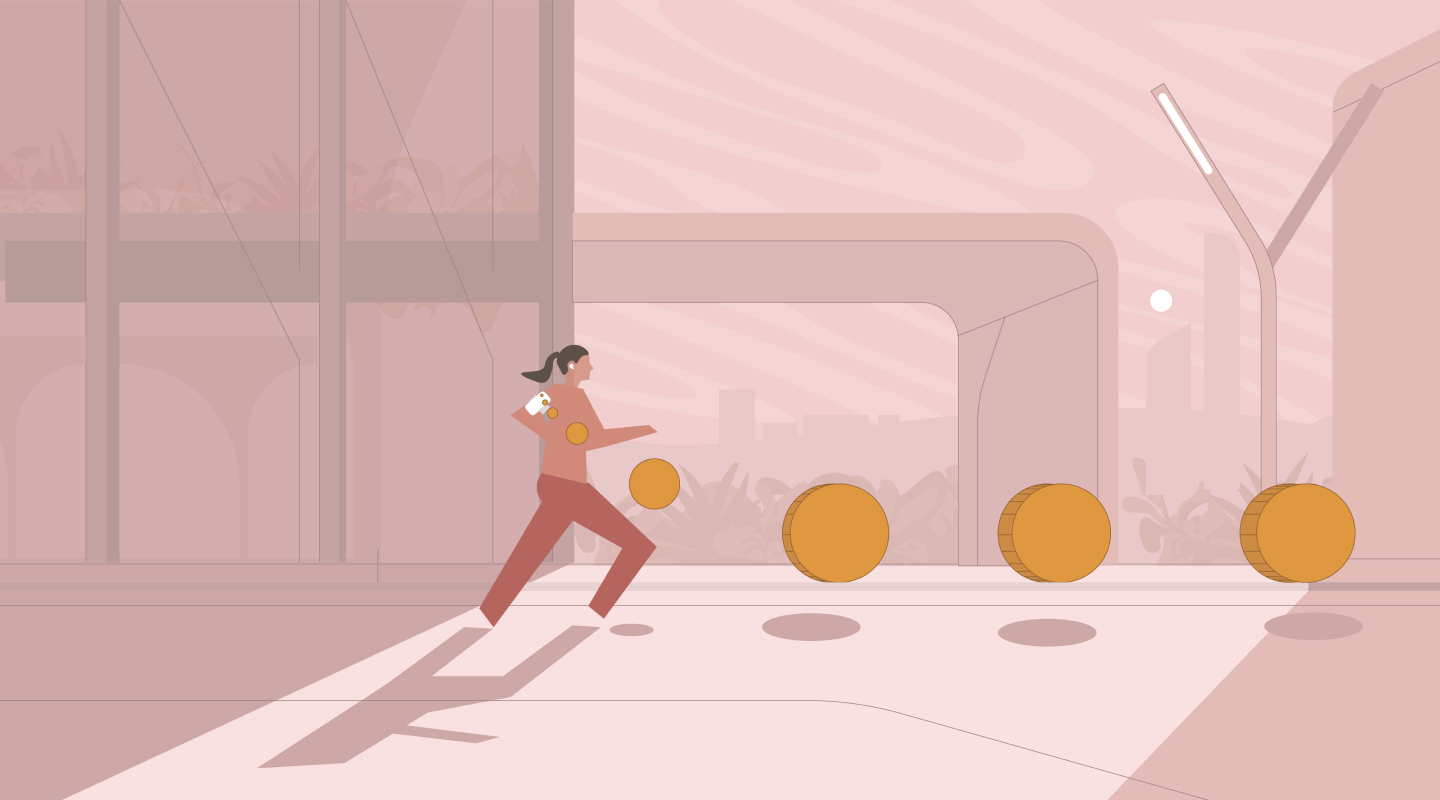

Several common health issues, including high blood pressure and obesity, stem from our contemporary lifestyles. These conditions are inevitably linked to individual behavior and habits like inactivity or chronic stress. Emerging digital products strive to confront these challenges and encourage healthy behavior changes, yet they frequently fall short in sustaining user motivation.
The primary challenge originates from a dilemma prevalent in behavioral sciences: the interests of our future self often clash with the immediate goals of our present self.
To avoid obesity-related complications years down the line, you have to forgo binge-watching your favorite show today, shop for healthy ingredients, and invest time in the kitchen. The situation is made even more difficult by the often intangible rewards: sustained energy investment (like working out at the gym) is required today, but the future benefit is the avoidance of an outcome, such as cardiovascular and mobility problems. We are more inclined to strive for positive outcomes rather than evading a distant negative consequence.
As stressed in the previous chapter, managing motivation is the most challenging aspect of the habit-building loop. In reality, successful product designs rarely consider motivation as a separate element but rather as one half of the motivation/effort equation. How can we do that?
Enter gamification, that is often used to boost the level of engagement during healthy habit-building. Using gamification techniques we encourage beneficial behaviors with rewards that evoke positive emotions in the present. In plain words, the goal is to sugarcoat the continuous effort required by creating "artificial" short-term rewards, as true benefits may not manifest until much later (or potentially won’t ever be noticeable).
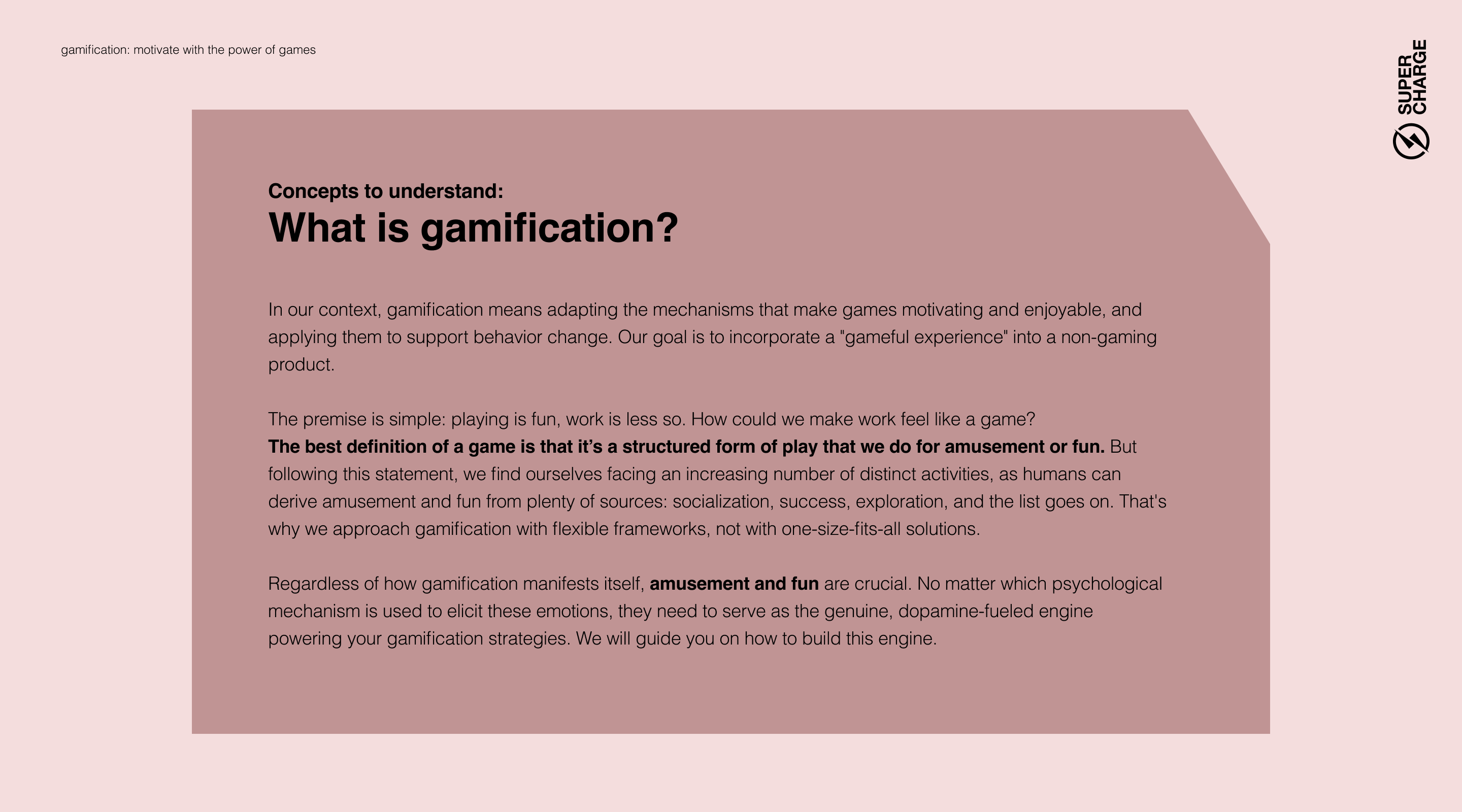
We advocate for involving game design techniques and mechanisms in non-game environments, as they convert mundane tasks into fun and engaging activities, and encourage customers to use the product regularly. However, it's critical to acknowledge that products that expect gamification to fully replace missing user motivation won't achieve their intended goals.
It’s best to think of gamification as an extra boost that pushes users through motivational valleys and eases the effort required to reach long-term goals. The primary motivation to lead a healthier life must either preexist or be cultivated through comprehensive educational initiatives that extend way beyond the scope of gamification.
On a practical level, this means you must first align a product's value creation model with customer needs and motivations, and then use gamification to enhance engagement and adherence. Gamification is a potent tool, but only when used thoughtfully.
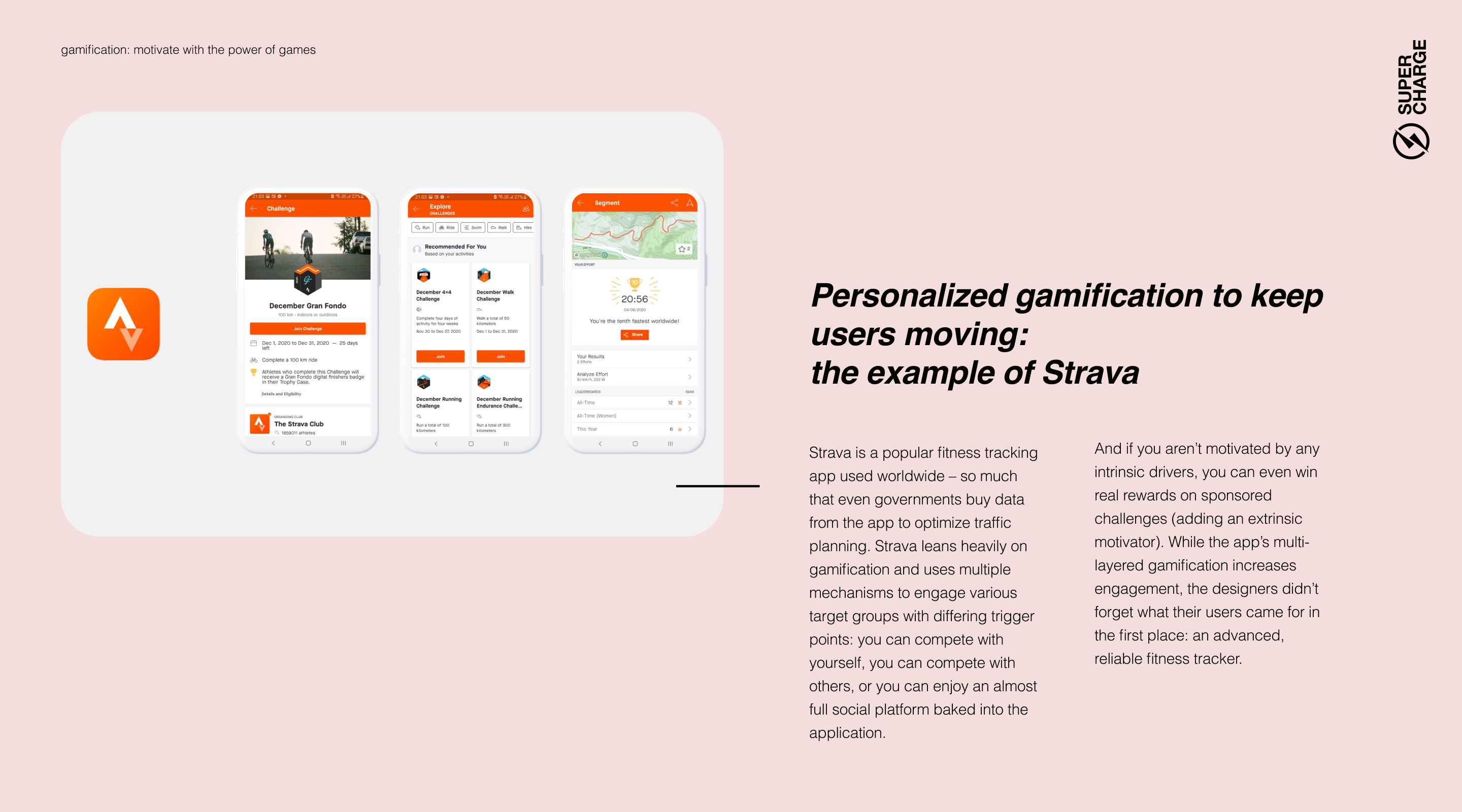
Gamification systems must be purpose built for your product's target user and their context. There is no one-size-fits-all model in gamification, even within the same product. Just because your customers have similar health needs, you might still need to segment them further based on the motivators that work for them. In most cases, you will end up with a mix of various game mechanics that target different drives to ensure you have most of your users covered.
Excessive gamification, or gamification misaligned with the preferences and needs of your user base can even detract from the primary goal of your product. While some apps successfully construct their entire experience around gamification (e.g., Duolingo), others employ it subtly as an incentive to motivate users without causing any distractions (e.g., the Headspace meditation app).
A bit confusing? Let us help! In the rest of this article, we showcase two gamification frameworks that can complement each other perfectly, before offering a way to use them together as a practical design process.
Gamification frameworks offer a systematic method for linking game mechanics to user goals to optimize human motivation. Among these, we find the Octalysis Framework* particularly insightful. It outlines eight fundamental drives that motivate users to participate in certain activities. This model can be visualized as an octagon, with each of the eight corners signifying a distinct core drive. First, we look at how the model is structured. After that, we'll explore each of the drivers in depth.
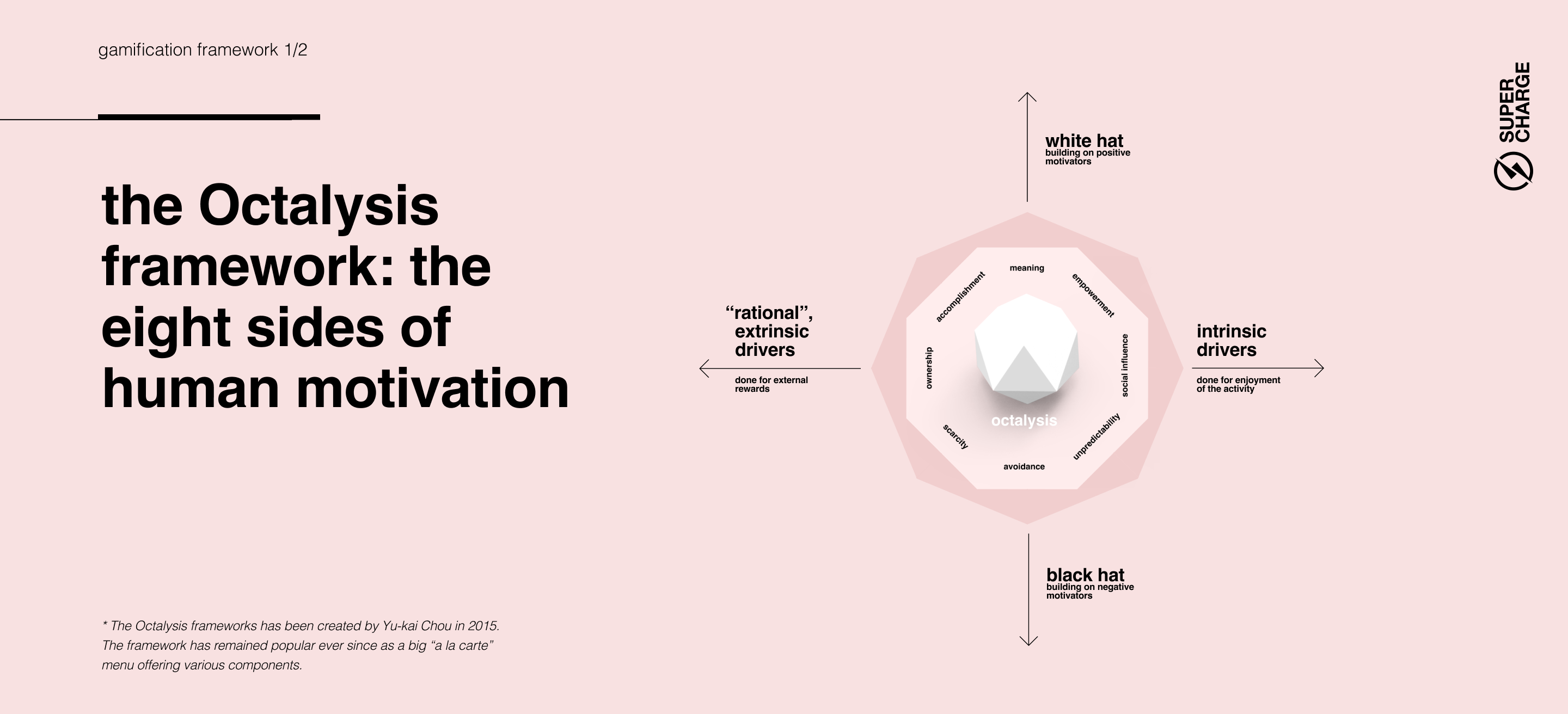
A helpful way to interpret the Octalysis model is to divide it horizontally:
Target both logical and emotional drivers simultaneously for a robust impact. Businesses traditionally aim at extrinsic customer motivation by offering external rewards for achieving certain goals. This is an uncomplicated value exchange that certainly has appeal. However, fostering participation in creative and social activities can generate mechanisms that boost motivation in a much more sustainable way and make the activity itself gratifying. For optimal results, it's often necessary to mix various drives, crafting a potent blend that addresses both extrinsic and intrinsic motivators at the same time.
Looking through a different lens, the framework can be divided into the upper and bottom segments:
Negative and positive emotions often go hand in hand
Black Hat drives aren't "forbidden tools". These drives harness negative emotions, leading to less uplifting but potentially effective feelings. They can be potent motivators, encouraging users to engage in beneficial activities. Remember, many great games incite enjoyment through a strategic blend of uncertainty followed by accomplishments. Success feels meaningful because of the looming threat of failure. Striking a balance between these elements is crucial for achieving the desired motivating experience.
Octalysis offers a large assortment of drive-game mechanics pairs and can be used to make sure the right motivators are targeted. It's a great way to think about the psychological drivers that can be leveraged to infuse our product with fun and amusement.
However, we find it useful to supplement it with something more focused on the practical delivery of the gamified experiences. Don't be intimidated by the name of the MDE framework, it actually offers us a simple and structured way to consider how our gamification efforts will work in the hands of real users, pushing our product goals forward.
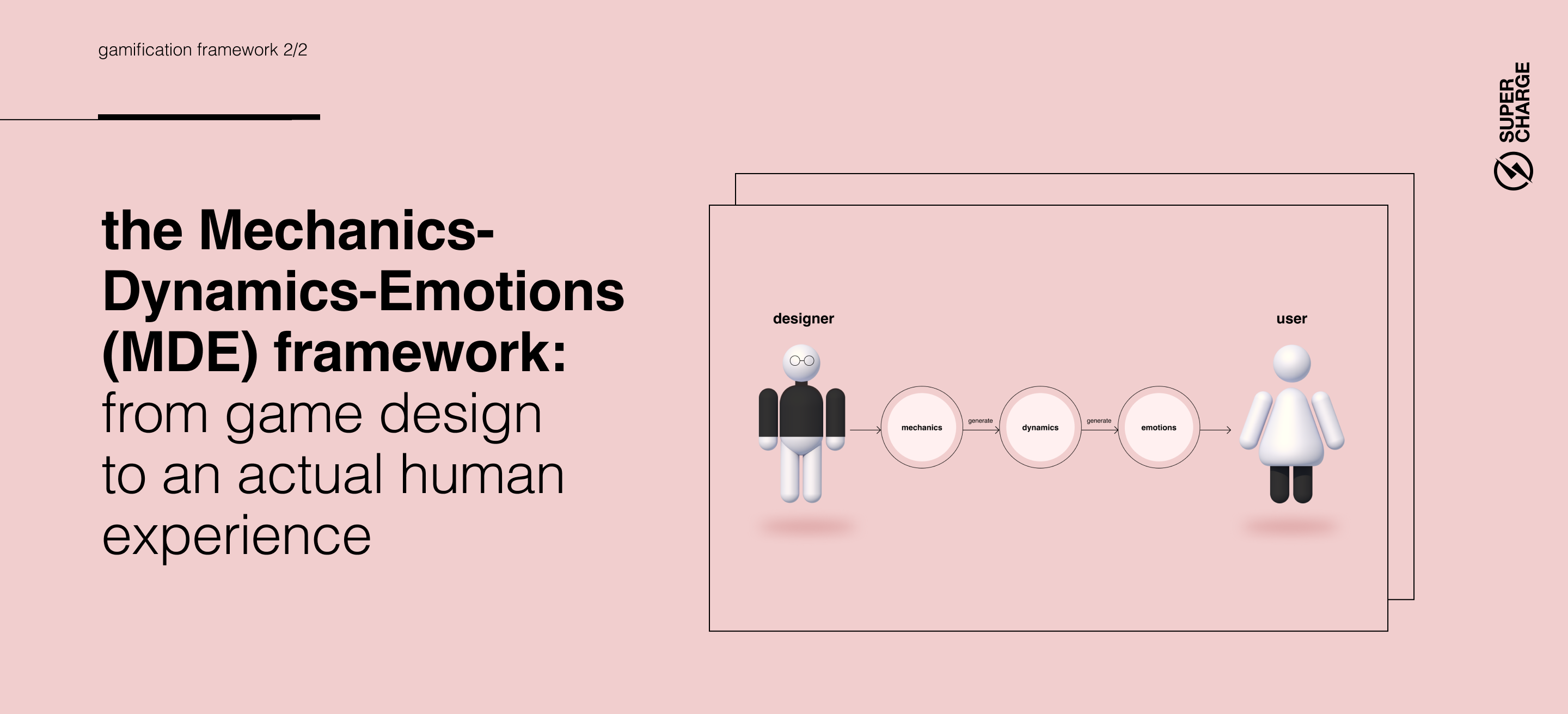
At the core of the model lies a fundamental truth: we can set a game's rules, but it's the users who create their own experiences by engaging with them. The model encourages us to view our gamification efforts as a process of constructing game mechanics. These mechanics then turn into dynamics as users interact with them, ultimately eliciting emotions and experiences (see diagram for easier understanding).
We selected a handful of drives from the Octalysis model that are best suited for health-related digital products and built a few examples, utilizing the MDE framework to better illuminate how it can be used to structure gamification efforts. If this all seems a bit theoretical, don’t worry: the following tables will show you how to use the MDE logical chain in practice.
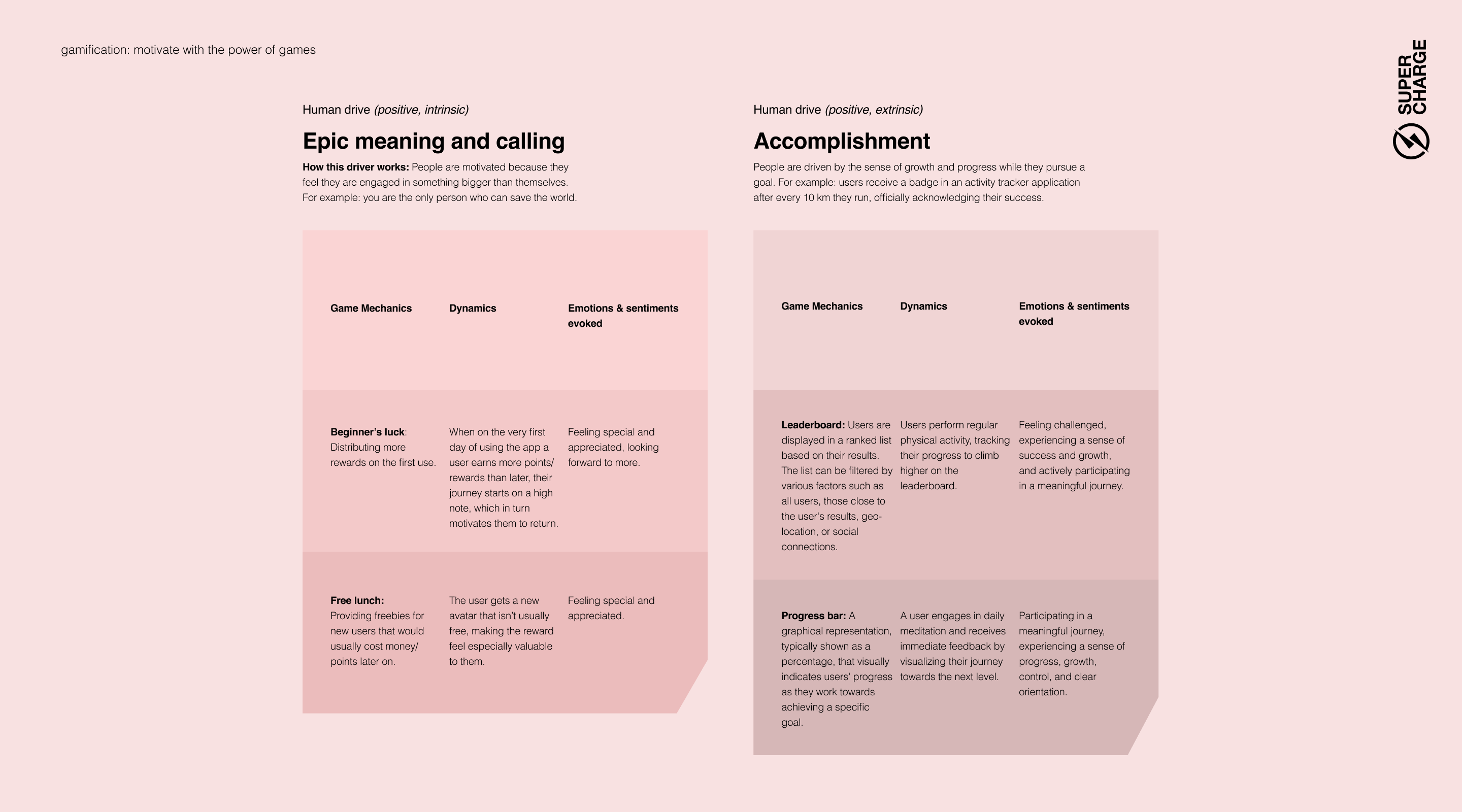
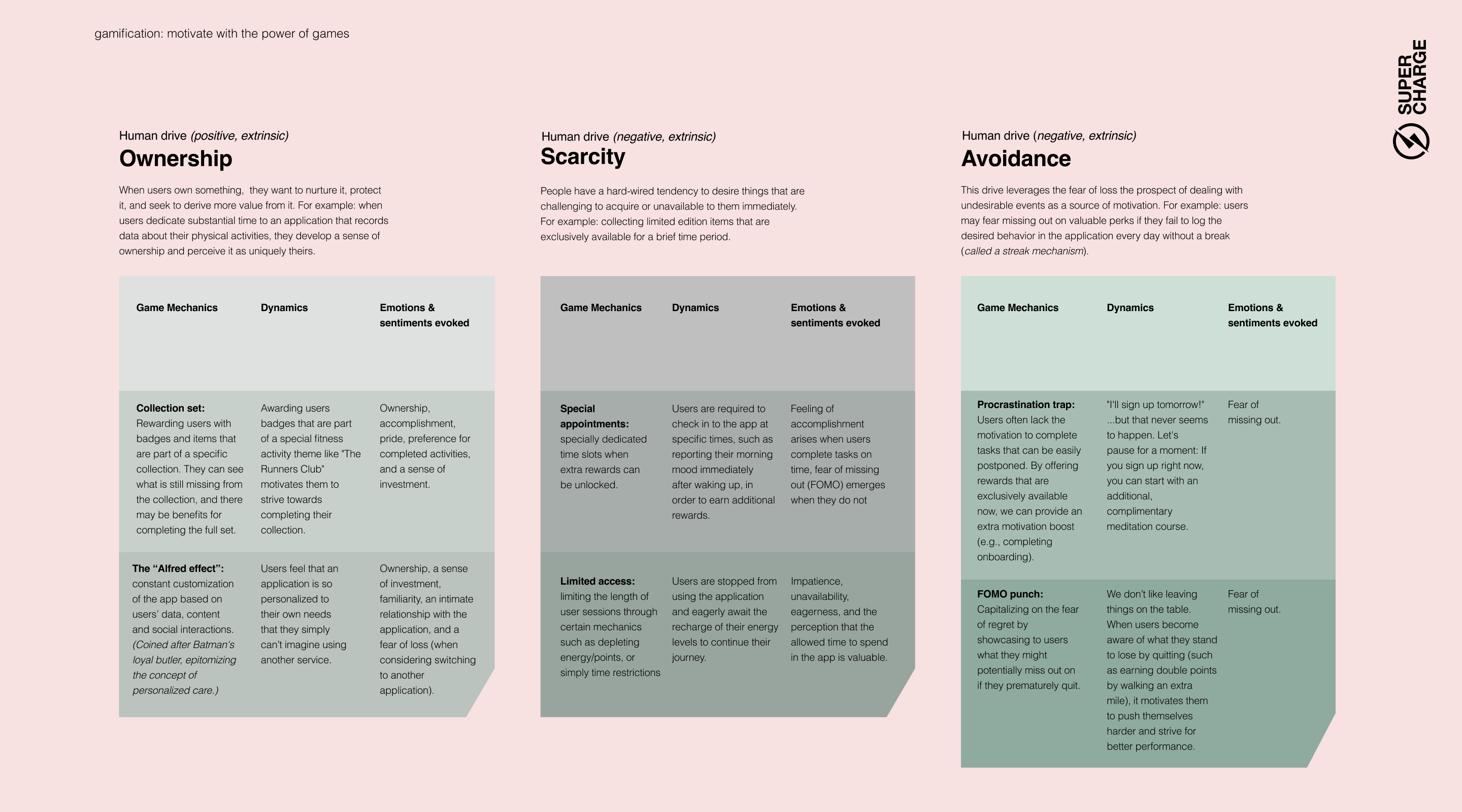
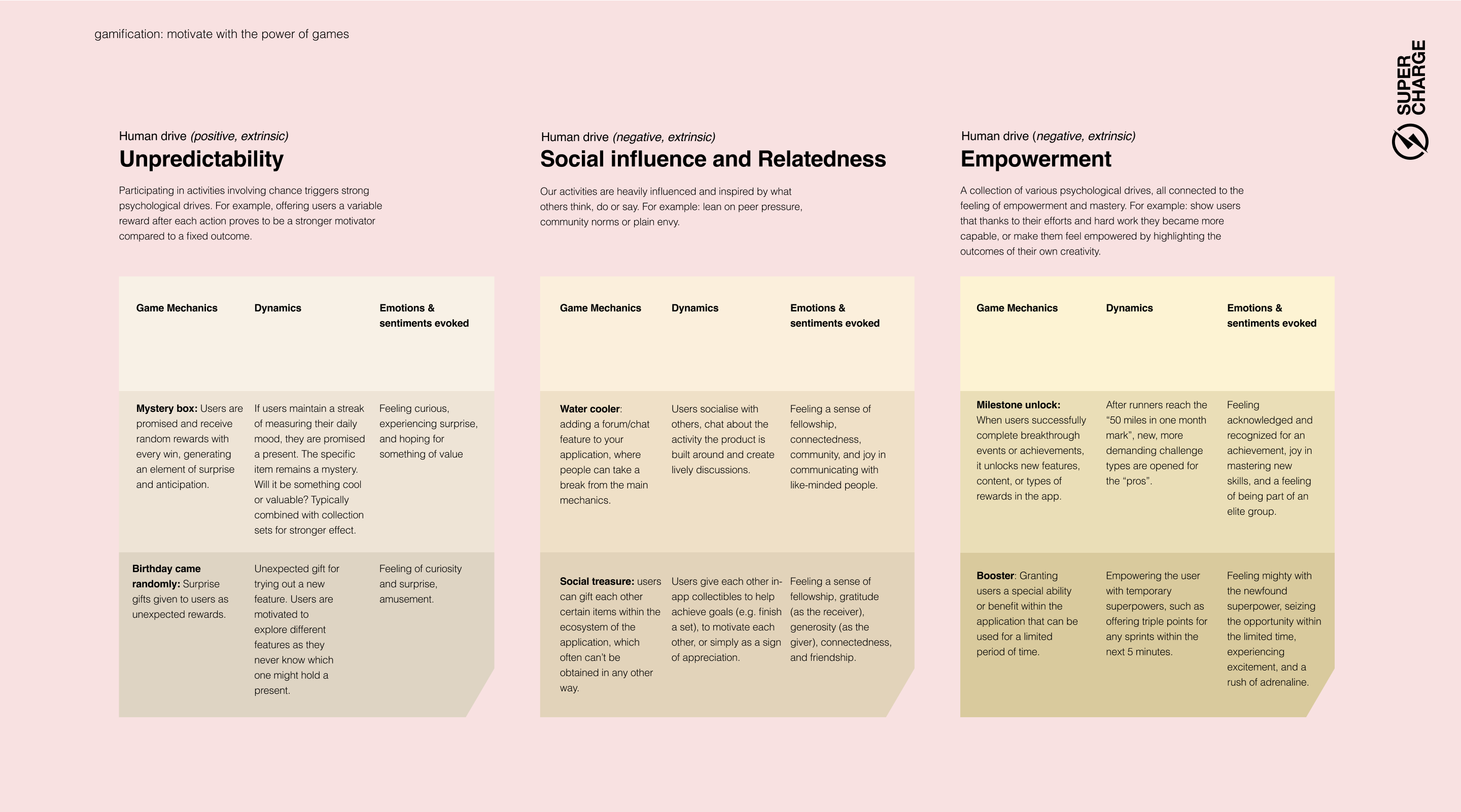
Let’s take a closer look at Apple’s Activity and Health tracker as a good example of a gamification experience that combines multiple mechanics. Anett, one of the authors of this report, utilizes this feature alongside other members of the Supercharge team. It enables team members to track and compare their performance in various activities like HIIT classes, long-distance runs, and exhilarating downhill bike rides. The collected data forms the basis for a leaderboard.
They constantly feel challenged, akin to navigating a massive shared obstacle course. The sense of fellowship is always present since they are also part of a real-life community. The collection of badges, which symbolize achievements, offers a continuous sense of accomplishment. Social influence from fellow participants and a genuine sense of relatedness naturally emerge within this context.
Engaging notifications provide instant feedback in a fun and motivating tone, serving as powerful drivers for members even during challenging early-morning runs. Additionally, the fear of finishing last on the leaderboard contributes significantly to their overall motivation. Their competitive nature ensures that none of them wants to be at the bottom, further fueling their drive to perform at their best.
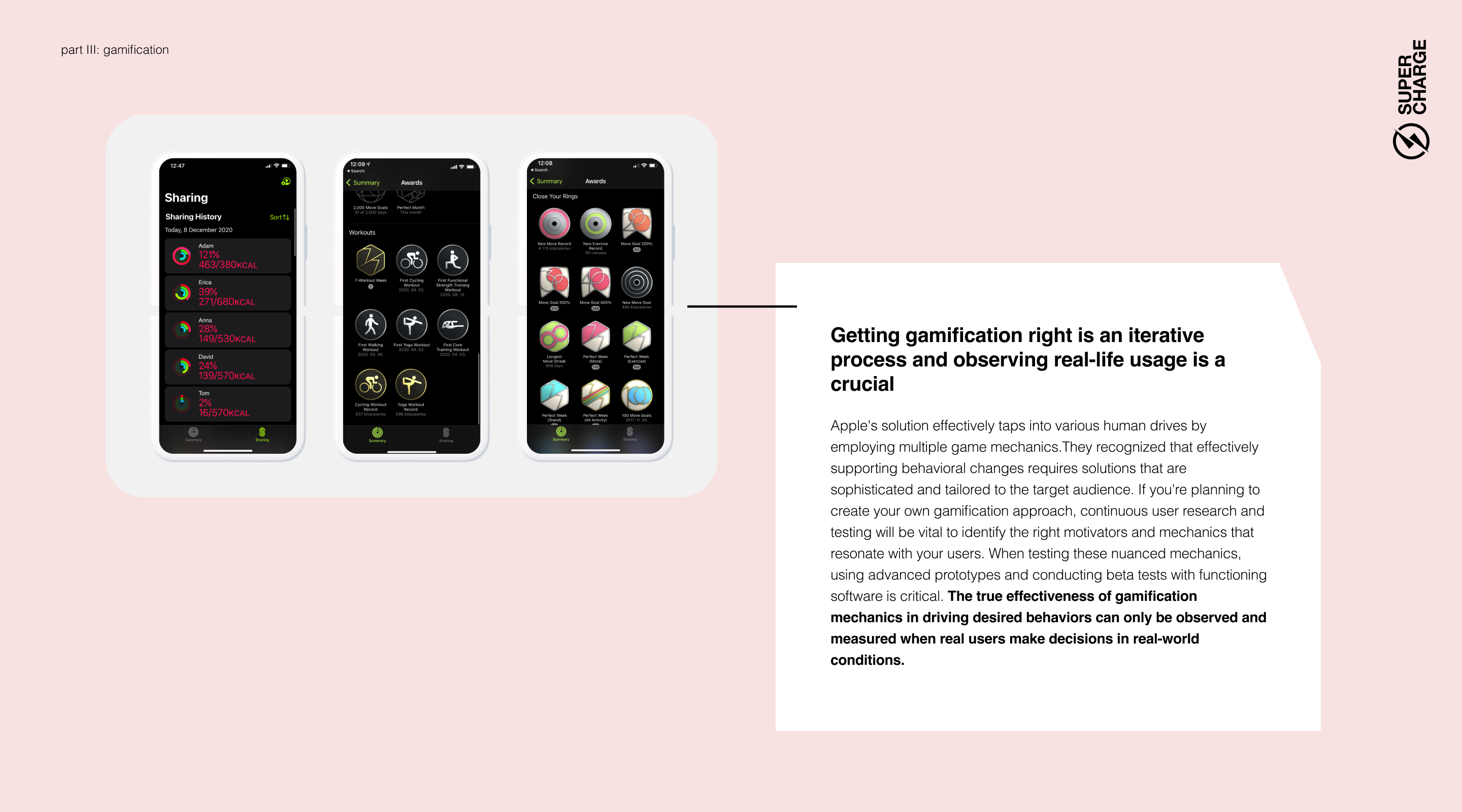
You are what you do, and a healthier self starts with healthier decisions and habits. Our own nature isn't always the best ally in our effort to change for the better, so we turn to technology to guide us to better decision-making in our personal health.
Digital devices have become our constant companions and we increasingly rely on them to augment our mental abilities in almost every area of life. Just think of the last time you attempted to drive to an unfamiliar location without the assistance of a navigation app... It is only natural, then, that we turn to technology to aid us in our quest for improved health and happiness.
“Is there an app for that?” – contrary to popular belief, it isn’t just Millennials and Gen Z users who ask this question. Their parents and grandparents are increasingly using their mobile phones as a natural extension of themselves. During the recent pandemic, even the most hard-line Luddites started to embrace technology, using it to see their grandchildren through the safety and distance of video chatting.
When it comes to health, it isn’t just patients who readily reach for digital solutions to track, support, and improve their well-being. Changing customer expectations are relentlessly forcing health practitioners to adopt new solutions, too. As this is happening, fresh opportunities and constant advancements in health-tech innovation are pushing medical professionals to embrace digitalization. Naturally, practitioners also find their everyday lives made more comfortable by technology, which further motivates them to integrate digital solutions into their healthcare practices.
We believe we are on the cusp of an era where it won’t be surprising for a psychiatrist to order SSRI and a daily dose of a meditation app for chronic anxiety. Doctors may soon routinely prescribe coaching apps for risk factors such as obesity. The trend of healthcare professionals embracing customer-facing health apps has already begun, and we think that the next logical step is to focus on solutions that promote positive behavior change and support prevention. Encouragingly, we are seeing an increasing number of potent solutions in this field that align with our perspective.
New digital tools offer more than just support for patients in their treatment or prevention efforts: their use generates a wealth of data, enabling a whole new level of understanding for practitioners. This is supported by AI-driven pattern recognition solutions that accelerate experts' work by offering insights instead of endless data streams and detecting anomalies that might escape the human eye. With millions of people constantly contributing their data to digital 'memory banks', we can achieve an understanding of systematic patterns unparalleled in the history of medicine.
Of course, the key is successful data collection, which can only happen with patients’ consent and collaboration. Applications that enable data collection while also ensuring user engagement will be vital in medical developments, again emphasizing the importance of leveraging behavioral sciences.
These recent times mark a new era of digitalization in one more way: the emergence of Generative AI, particularly Large Language Models, thrust into prominence by ChatGPT. This technology enables an entirely novel form of human-computer interaction, one that feels much more intuitive to humans. LLMs open up whole new perspectives for digital companion applications, enabling the development of solutions that rival human coaches in understanding users and providing personalized advice.
We couldn't be more thrilled to tap into these emerging opportunities, to assist our clients in crafting solutions that steer their customers towards healthier, happier lives, and to witness the contributions other healthcare innovators make to the world.